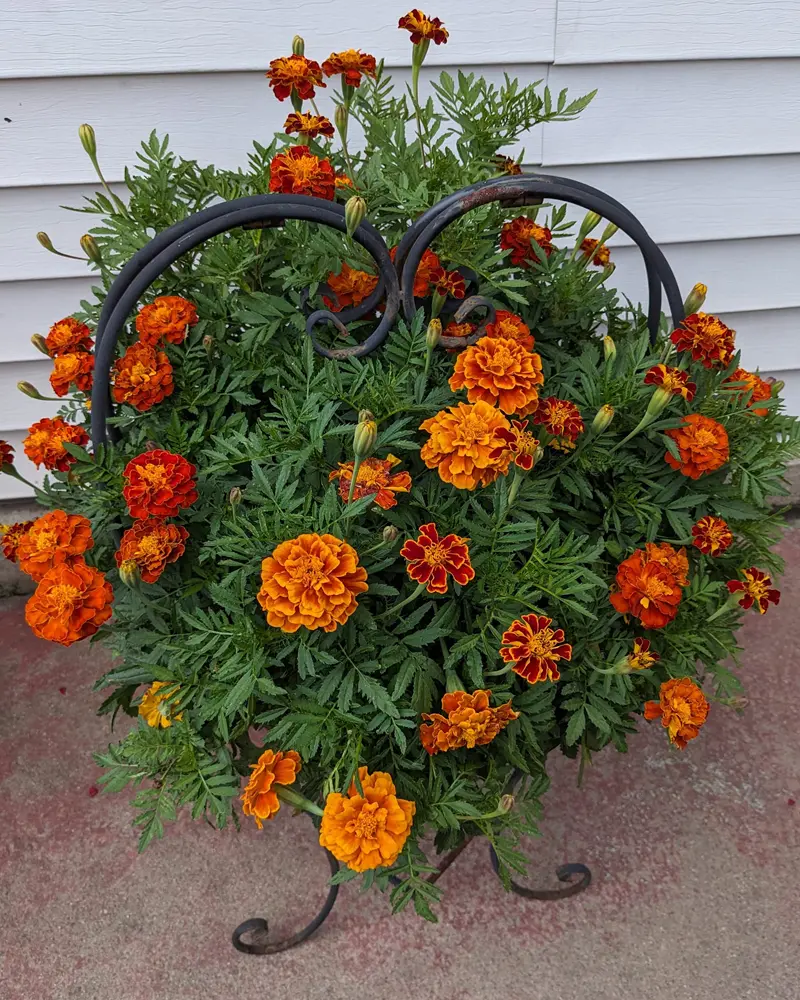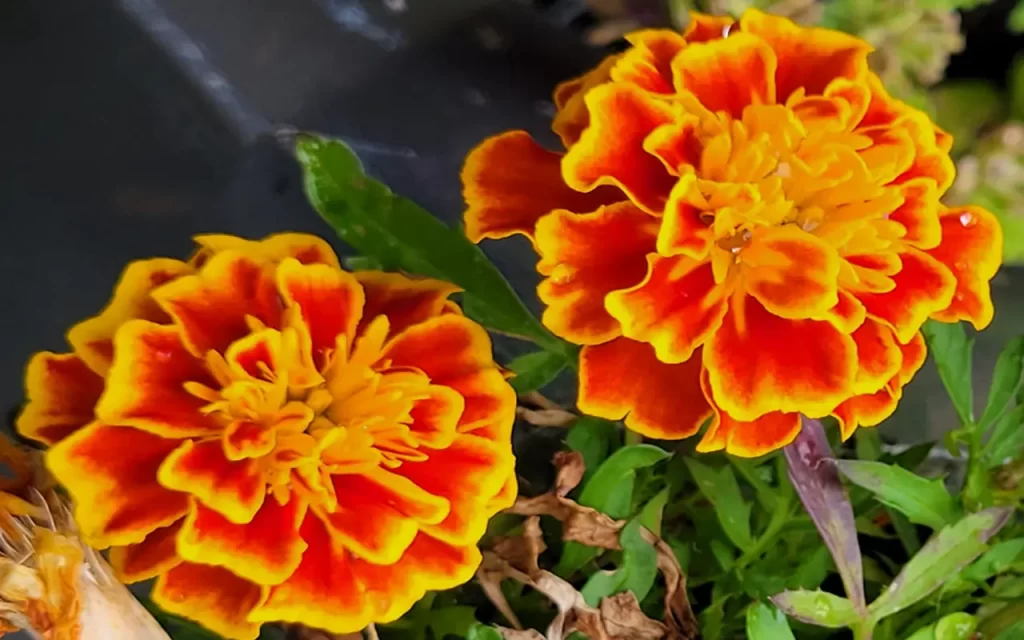Marigolds are a vibrant, resilient addition to any garden. Known for their cheerful, golden hues and pest-repelling properties, these flowers are perfect for both novice and experienced gardeners. This guide will take you through everything you need to know about growing marigolds, from planting and care to troubleshooting common issues, ensuring a flourishing display of these beautiful blooms in your garden.
What Are Marigolds?
Marigolds (Tagetes spp.) are sun-loving, easy-to-grow annuals that come in a variety of sizes and colors, primarily golden, orange, and yellow. They are native to Mexico and Central America, but their adaptability has made them popular worldwide. The two most common types are:
- African Marigolds (Tagetes erecta) – Known for their large, round blooms, they can grow up to three feet tall, making them a stunning choice for garden borders.
- French Marigolds (Tagetes patula) – Smaller and bushier, these marigolds are ideal for edging and container gardens, providing long-lasting color with continuous blooms.
Benefits of Growing Marigolds in Your Garden
Marigolds are not only beautiful but also highly beneficial for your garden:
- Pest Repellent: Marigolds naturally repel pests, especially nematodes and aphids, due to their strong scent. Planting marigolds around vegetables can protect crops from unwanted pests.
- Attracts Pollinators: Bees and butterflies are drawn to marigolds, helping to increase pollination in your garden.
- Soil Improvement: Marigold roots help suppress nematodes in the soil, which can be damaging to other plants.
Choosing the Right Location for Marigolds

Marigolds thrive in full sun and require at least six hours of sunlight per day. They are highly adaptable and can grow in various soil types but prefer well-draining, moderately fertile soil. While marigolds are relatively drought-tolerant, they perform best with consistent moisture.
Ideal Soil Conditions
- pH Range: Marigolds grow well in slightly acidic to neutral soil, with a pH between 6.0 and 7.0.
- Soil Drainage: Ensure that the soil drains well to avoid waterlogged roots, as marigolds are prone to root rot in overly wet conditions.
How to Plant Marigolds
Starting from Seeds
Marigolds are easy to grow from seeds, which can be sown directly outdoors after the last frost. Here’s a step-by-step guide:
- Prepare the Soil: Loosen the top layer of soil and remove any weeds or debris.
- Sow the Seeds: Scatter marigold seeds over the soil and cover them lightly with a thin layer of soil.
- Watering: Water gently but thoroughly to settle the soil.
- Germination: Seeds typically germinate within 5-7 days in warm conditions.
Transplanting Marigold Seedlings
If you prefer to start seeds indoors, plant them in seed trays about six to eight weeks before the last frost date. Once the seedlings have two sets of true leaves, they can be transplanted outside.
- Spacing: Space African marigolds 12-18 inches apart, while French marigolds should be 6-9 inches apart.
- Planting Depth: Set the seedlings at the same depth they were growing in the trays, making sure not to bury the stem.
- Watering After Transplanting: Water well after transplanting to help the plants establish in their new location.
Caring for Marigolds
Watering
Marigolds prefer moderate moisture but are fairly drought-tolerant once established. Follow these watering tips for the best results:
- Frequency: Water deeply once a week, allowing the soil to dry slightly between waterings.
- Avoid Overwatering: Water at the base of the plants to avoid wetting the foliage, as excessive moisture on leaves can lead to fungal diseases.
Fertilizing
Marigolds are low-maintenance and do not require heavy feeding. However, a light feeding with a balanced fertilizer can enhance their growth and blooming.
- Timing: Apply fertilizer at planting time, and again once the plants start blooming.
- Type: Use a balanced, slow-release fertilizer or an organic option like compost to improve soil nutrients without overstimulating foliage growth.
Deadheading and Pruning
Regular deadheading (removing spent blooms) encourages continuous flowering and keeps the plants looking tidy. Marigolds respond well to light pruning, which helps maintain their shape and prevents leggy growth.
- Deadheading: Pinch off faded blooms just above the nearest set of leaves.
- Pruning: Lightly trim back the plants if they become too bushy or leggy to encourage compact growth.
Common Pests and Problems

Pests
While marigolds repel many garden pests, they can still be affected by a few, including:
- Spider Mites: Tiny pests that create fine webs on leaves, causing them to turn yellow. Treat with insecticidal soap or neem oil.
- Aphids: Small green or black insects that cluster on young stems and leaves. Rinse them off with a strong spray of water or use insecticidal soap.
- Slugs and Snails: These can chew holes in marigold leaves, especially in damp weather. Place copper tape around pots or use slug bait to deter them.
Diseases
Marigolds are susceptible to some fungal diseases if conditions are overly wet. To prevent disease:
- Root Rot: Caused by waterlogged soil. Ensure proper drainage and avoid overwatering.
- Powdery Mildew: A fungal disease that appears as white powder on leaves. Improve air circulation and water at the base of plants to prevent moisture on leaves.
- Botrytis Blight: This disease causes gray mold on leaves and flowers, particularly in humid conditions. Remove affected parts and ensure adequate spacing for airflow.
Harvesting Marigold Seeds
Marigolds are easy to propagate by saving seeds from mature flowers. To harvest seeds:
- Wait for the Blooms to Fade: Allow the flower heads to dry completely on the plant.
- Collect the Seeds: Once the flower heads turn brown and papery, snip them off and gently open them to reveal the seeds.
- Store: Store seeds in a dry, cool place until you’re ready to plant next season.
Companion Planting with Marigolds
Marigolds are excellent companions for many plants in the vegetable garden. They repel pests and attract beneficial insects, making them ideal for natural pest management. Pair marigolds with:
- Tomatoes: Marigolds help repel nematodes and aphids from tomato plants.
- Peppers: Marigolds deter pests that commonly target peppers, enhancing their growth and health.
- Squash and Melons: Marigolds help keep pests like squash bugs and cucumber beetles at bay.
Seasonal Care for Marigolds
Spring and Summer
- Planting Time: Begin planting marigolds after the last frost when the soil has warmed up.
- Regular Maintenance: Water consistently, deadhead regularly, and keep an eye out for pests during the growing season.
Fall
- Prepare for Frost: Marigolds are annuals and will die off with the first hard frost. However, you can extend their blooming season by covering them on chilly nights.
- Collect Seeds: Harvest seeds from mature plants in fall to save for next year’s garden.
Winter Care
Since marigolds are annuals, they do not survive the winter in most regions. However, in frost-free areas, marigolds may reseed naturally or even bloom year-round.
Frequently Asked Questions About Growing Marigolds
How Long Do Marigolds Bloom?
Marigolds bloom from late spring through fall, providing continuous color in the garden as long as they are regularly deadheaded and well-maintained.
Can Marigolds Grow in Pots?
Yes, marigolds are excellent container plants. Ensure the pots have good drainage, and use a quality potting mix to keep marigolds healthy and vibrant.
With their cheerful colors, pest-repelling properties, and low-maintenance nature, marigolds are a wonderful addition to any garden. By following these tips, you can enjoy a long season of bright, beautiful blooms that add charm and value to your outdoor space.


